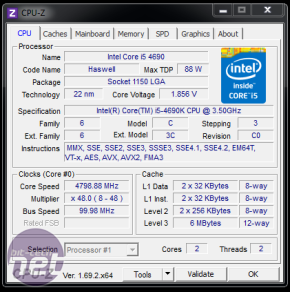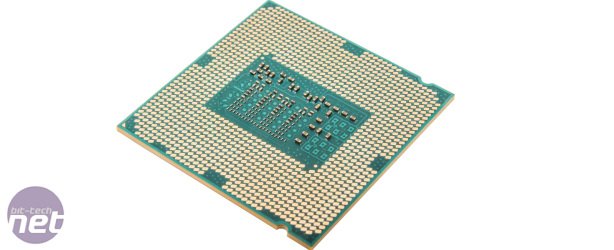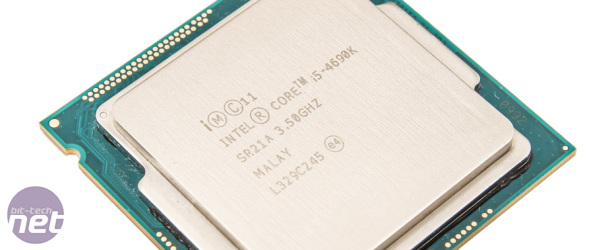Overclocking
 We should note that we haven't received a press/engineering sample from Intel so this is a retail CPU so the overclocking potential should be similar to what you can expect if you went out and bought one now. The press sample Core i7-4790K managed 4.8GHz using a vcore of 1.33V so we used that as a benchmark for the retail Core i5-4690K. Using the same voltage and 48x multiplier, we booted into Windows first time and 100 per cent stable too.
We should note that we haven't received a press/engineering sample from Intel so this is a retail CPU so the overclocking potential should be similar to what you can expect if you went out and bought one now. The press sample Core i7-4790K managed 4.8GHz using a vcore of 1.33V so we used that as a benchmark for the retail Core i5-4690K. Using the same voltage and 48x multiplier, we booted into Windows first time and 100 per cent stable too. We headed back into the EFI to try for 4.9GHz and were surprised to see it boot okay. However, Prime95 lasted just a few seconds before we were met with a BSOD. We gradually ramped up the voltage in an attempt to get 4.9GHz rock steady but even at a toasty 1.4V, which saw the load temperature breach 90°C in Prime95's smallFFT's test, it still wasn't totally stable.
In the end, the exact same voltage as we used with the Core i7 proved to be the lowest stable setting, although with decent water cooling, it may be possible to get slightly higher than we achieved here with our Corsair H80i.
Needless to say, 1.4V at 4.9GHz and barely touching 90°C is a lot cooler than you'd see a Core i5-4670K running at. In fact, we regularly saw similar temperatures around 4.8GHz and 1.3V so it's clear Intel's new thermal paste seems to be doing a good job.
Performance Analysis
The extra 100MHz stock and Turbo-Boosted frequencies saw noticeable gains over the Core i5-4670K across the board. Overall, in the Media Benchmarks it was a good chunk faster at stock speed. It was actually fairly close to toppling the Core i7-3770K, despite the latter sporting Hyper-Threading and four extra virtual cores as a result and did manage to better the Core i7-2600K, being over 200 points clear of the Core i5-2500K overall.
The Pentium G3258 on the other hand was way down the table with 1,579 points overall compared to 2,328 for the Core i5. Clearly there's no competition from the budget CPU here, at least at stock speeds. The Elder Scrolls V: Skyrim again saw small improvements compared to older CPUs, but this was one area where again the Pentium G3258 was noticeably slower than the Core i5 and the same was true in the Shogun 2: Total War CPU Test. Unigene Valley also saw the Pentium sit well below the Core i5-4690K although the former did make up considerable ground once overclocked.
Click to enlarge
Cinebench is all about more cores is better and as a result, does paint a fair rosy picture for AMD's 8-core FX-8350, which was faster than the Core i5-4690K in both R15 and the older R11.5. Once overclocked, the Intel CPU reigned in the AMD chip a little, and was certainly faster than the latter at stock speed, but with both CPUs clocked at 4.8GHz, the FX-8350 was still a tad faster. That said, it's power consumption was a huge amount more here - 364W compared to just 180W for the overclocked Core i5. The AMD CPU may be cheaper but if you do a lot of multi-threaded work then you could well recover these costs in cheaper electricity bills by going the Intel route.
In the Media Benchmarks, the Pentium G3258 saw a huge boost once overclocked, and it came close to matching the Core i5-4690K at stock speed. However, the latter was nearly 800 points clear once it too had been overclocked. It also saw substantial gains in The Elder Scrolls: Skyrim, with the minimum frame rate rising from 90fps to 105fps so its clear that where you need the extra grunt from a CPU in games, the Core i5-4690K has what it takes to keep up with a high-end GPU. It also topped the Shogun 2: Total War CPU Test and was 10 per cent faster than both the Core i5-4670K and Core i5-3570K here too.
We had one odd result that we weren't expecting, which was the idle power consumption at stock speed. At 48W this was lower than a Core i3-4130, but having checked everything was as it should be we decided to run with the figure, which is around 30W lower than the Core i5-4670K. It was also fairly power-frugal under load, and was just 11W more power-hungry than the Core i3-4130 at stock speed, while at 4.8GHz, the extra voltage required compared to previous generation CPUs saw it pull between 10 and 20W more at 180W for the system as a whole.
Click to enlarge
Conclusion
Three months ago we were certainly hoping for 5GHz+ in terms of overclocking for both of the Devil's Canyon CPUs. Sadly, at least with high end air coolers and all-in-one liquid coolers, 4.8GHz is probably what you can expect to achieve, although these things are always down to individual CPUs of course. On the other had the 4.8GHz we achieved here and with the Core i7 and Pentium G3258 were very easy to nail in terms of temperatures, so we expect higher overclocks with the new CPUs on average compared to their predecessors.
Performance-wise, as we've seen for a couple of generations now, if you own a Core i5-4670K, there's little point upgrading unless you want a more overclocking-friendly CPU, or at least a CPU that runs cooler. Apart from this, there's not enough reason to upgrade. Even compared to the Core i5-3570K there's still an argument for holding on until the next mid-range CPU from Intel - Broadwell is released around the end of the year, although in some situations, namely Cinebench and games, there are stronger arguments and these get pretty convincing once you go back as far as a Core i5-2500K.
In summary, the Core i5-4690K is the CPU you should be buying if you're an Intel Z87/Z97 system owner with a budget of between £150 and £190 and are up for a bit of overclocking. Given the cooler temperatures and faster speeds compared to its Haswell-based predecessors, there's little point opting for an older CPU although owners of Ivy Bridge CPUs may want to wait for Broadwell to see more significant performance gains.

-
Speed43 / 50
-
Features13 / 15
-
Value29 / 35


MSI MPG Velox 100R Chassis Review
October 14 2021 | 15:04











Want to comment? Please log in.